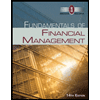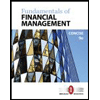
Fundamentals of Financial Management, Concise Edition
10th Edition
ISBN: 9781337911054
Author: Eugene F. Brigham, Joel F. Houston
Publisher: Cengage Learning US
expand_more
expand_more
format_list_bulleted
Textbook Question
Chapter 10, Problem 1TCL
CALCULATING 3M’S COST OF CAPITAL
Use online resources to work on this chapter’s questions. Please note that website information changes over time, and these changes may limit your ability to answer some of these questions.
In this chapter, we described how to estimate a company’s WACC, which is the weighted average of its costs of debt,
DISCUSSION QUESTIONS
- 1. As a first step, we need to estimate what percentage of MMM’s capital comes from debt, preferred stock, and common equity This information can be found on the firm’s latest annual
balance sheet . (As of year end 2017, МММ had no preferred stock.) Total debt includes all interest-bearing debt and is the sum of short-term debt and long-term debt.- a. Recall that the weights used in the WACC are based on the company’s target capital structure. If we assume that the company wants to maintain the same mix of capital that it currently has on its balance sheet, what weights should you use to estimate the WACC for МММ?
- b. Find MMM’s market capitalization, which is the market value of its common equity. Using the sum of its short-term debt and long-term debt from the balance sheet (we assume that the market value of its debt equals its book value) and its market capitalization, recalculate the firm’s debt and common equity weights to be used in the WACC equation. These weights are approximations of market-value weights. Be sure not to include accruals in the debt calculation.

Expert Solution & Answer
Want to see the full answer?
Check out a sample textbook solution
Students have asked these similar questions
As CFO for Everything.Com, you are shopping for 6,000 square feet of usable office space for 25 of your employees in Center City,
USA. A leasing broker shows you space in Apex Atrium, a 10-story multitenanted office building. This building contains 360,000 square
feet of gross building area. A total of 54,000 square feet is interior space and is nonrentable. The nonrentable space consists of areas
contained in the basement, elevator core, and other mechanical and structural components. An additional 36,000 square feet of
common area is the lobby area usable by all tenants. The 6,000 square feet of usable area that you are looking for is on the seventh
floor, which contains 33,600 square feet of rentable area, and is leased by other tenants who occupy a combined total of 24,000
square feet of usable space. The leasing broker indicated that base rents will be $30 per square foot of rentable area
Required:
a. Calculate total rentable area in the building as though it would be rented to…
Don't used Ai solution
General Finance Question
Chapter 10 Solutions
Fundamentals of Financial Management, Concise Edition
Ch. 10 - Prob. 1QCh. 10 - Assume that the risk-free rate increases, but the...Ch. 10 - How should the capital structure weights used to...Ch. 10 - Suppose a firm estimates its WACC to be 10%....Ch. 10 - The WACC is a weighted average of the costs of...Ch. 10 - AFTER-TAX COST OF DEBT The Holmes Companys...Ch. 10 - COST OF PREFERRED STOCK Torch Industries can issue...Ch. 10 - COST OF COMMON EQUITY Pearson Motors has a target...Ch. 10 - COST OF EQUITY WITH AND WITHOUT FLOTATION Jarett ...Ch. 10 - PROJECT SELECTION Midwest Water Works estimates...
Ch. 10 - COST OF COMMON EQUITY The future earnings,...Ch. 10 - COST OF COMMON EQUITY WITH AND WITHOUT FLOTATION...Ch. 10 - COST OF COMMON EQUITY AND WACC Palencia Paints...Ch. 10 - WACC The Paulson Companys year-end balance sheet...Ch. 10 - WACC Olsen Outfitters Inc. believes that its...Ch. 10 - Prob. 11PCh. 10 - WACC Empire Electric Company (EEC) uses only debt...Ch. 10 - COST OF COMMON EQUITY WITH FLOTATION Banyan Co.s...Ch. 10 - Prob. 14PCh. 10 - WACC AND COST OF COMMON EQUITY Kahn Inc. has a...Ch. 10 - COST OF COMMON EQUITY The Bouchard Companys EPS...Ch. 10 - Prob. 17PCh. 10 - Prob. 18PCh. 10 - ADJUSTING COST OF CAPITAL FOR RISK Ziege Systems...Ch. 10 - WACC The following table gives Foust Companys...Ch. 10 - CALCULATING THE WACC Here is the condensed 2019...Ch. 10 - COST OF CAPITAL Coleman Technologies is...Ch. 10 - CALCULATING 3MS COST OF CAPITAL Use online...
Knowledge Booster
Learn more about
Need a deep-dive on the concept behind this application? Look no further. Learn more about this topic, finance and related others by exploring similar questions and additional content below.Similar questions
- Consider the following simplified financial statements for the Yoo Corporation (assuming no income taxes): Income Statement Balance Sheet Sales Costs $ 40,000 Assets 34,160 $26,000 Debt Equity $ 7,000 19,000 Net income $ 5,840 Total $26,000 Total $26,000 The company has predicted a sales increase of 20 percent. Assume Yoo pays out half of net income in the form of a cash dividend. Costs and assets vary with sales, but debt and equity do not. Prepare the pro forma statements. (Input all amounts as positive values. Do not round intermediate calculations and round your answers to the nearest whole dollar amount.) Pro forma income statement Sales Costs $ 48000 40992 Assets $ 31200 Pro forma balance sheet Debt 7000 Equity 19000 Net income $ 7008 Total $ 31200 Total 30304 What is the external financing needed? (Do not round intermediate calculations. Negative amount should be indicated by a minus sign.) External financing needed $ 896arrow_forwardAn insurance company has liabilities of £7 million due in 10 years' time and £9 million due in 17 years' time. The assets of the company consist of two zero-coupon bonds, one paying £X million in 7 years' time and the other paying £Y million in 20 years' time. The current interest rate is 6% per annum effective. Find the nominal value of X (i.e. the amount, IN MILLIONS, that bond X pays in 7 year's time) such that the first two conditions for Redington's theory of immunisation are satisfied. Express your answer to THREE DECIMAL PLACES.arrow_forwardAn individual is investing in a market where spot rates and forward rates apply. In this market, if at time t=0 he agrees to invest £5.3 for two years, he will receive £7.4 at time t=2 years. Alternatively, if at time t=0 he agrees to invest £5.3 at time t=1 for either one year or two years, he will receive £7.5 or £7.3 at times t=2 and t=3, respectively. Calculate the price per £5,000 nominal that the individual should pay for a fixed-interest bond bearing annual interest of 6.6% and is redeemable after 3 years at 110%. State your answer at 2 decimal places.arrow_forward
- The one-year forward rates of interest, f+, are given by: . fo = 5.06%, f₁ = 6.38%, and f2 = 5.73%. Calculate, to 4 decimal places (in percentages), the three-year par yield.arrow_forward1. Give one new distribution channels for Virtual Assistance (freelance business) that is not commonly used. - show a chart/diagram to illustrate the flow of the distribution channels. - explain the rationale behind it. (e.g., increased market reach, improved customer experience, cost-efficiency). - connect the given distribution channel to the marketing mix: (How does it align with the overall marketing strategy? Consider product, price, promotion, and place.). - define the target audience: (Age, gender, location, interests, etc.). - lastly, identify potential participants: (Wholesalers, retailers, online platforms, etc.)arrow_forwardAn individual is planning for retirement and aims to withdraw $100,000 at the beginning of each year, starting from the first year of retirement, for an expected retirement period of 20 years. To fund this retirement plan, he intends to make 20 equal annual deposits at the end of each year during his working years. Assume a simple annual interest rate of 20% during his working years and a simple annual interest rate of 5% during retirement. What should his annual deposit amount be to achieve his desired retirement withdrawals? Please write down the steps of your calculation and explain result economic meaning.arrow_forward
- Assume an investor buys a share of stock for $18 at t=0 and at the end of the next year (t=1), he buys 12 shares with a unit price of $9 per share. At the end of Year 2 (t=2), the investor sells all shares for $40 per share. At the end of each year in the holding period, the stock paid a $5.00 per share dividend. What is the annual time-weighted rate of return? Please write down the steps of your calculation and explain result economic meaning.arrow_forwardOn how far do you endorse this issue? Analyze the situation critically using official statistics and the literature.arrow_forwardIs globalization a real catalyst for enhancing international business? It is said that relevance of globalization and regionalism in the current situation is dying down. More specifically, concerned has been raised from different walks of life about Nepal’s inability of reaping benefits of joining SAFTA, BIMSTEC and WTO.arrow_forward
- In the derivation of the option pricing formula, we required that a delta-hedged position earn the risk-free rate of return. A different approach to pricing an option is to impose the condition that the actual expected return on the option must equal the equilibrium expected return. Suppose the risk premium on the stock is 0.03, the price of the underlying stock is 111, the call option price is 4.63, and the delta of the call option is 0.4. Determine the risk premium on the option.arrow_forwardGeneral Financearrow_forwardAssume an investor buys a share of stock for $18 at t = 0 and at the end of the next year (t = 1) , he buys 12 shares with a unit price of $9 per share. At the end of Year 2 (t = 2) , the investor sells all shares for $40 per share. At the end of each year in the holding period, the stock paid a $5.00 per share dividend. What is the annual time-weighted rate of return?arrow_forward
arrow_back_ios
SEE MORE QUESTIONS
arrow_forward_ios
Recommended textbooks for you
 Fundamentals Of Financial Management, Concise Edi...FinanceISBN:9781337902571Author:Eugene F. Brigham, Joel F. HoustonPublisher:Cengage Learning
Fundamentals Of Financial Management, Concise Edi...FinanceISBN:9781337902571Author:Eugene F. Brigham, Joel F. HoustonPublisher:Cengage Learning Fundamentals of Financial Management (MindTap Cou...FinanceISBN:9781285867977Author:Eugene F. Brigham, Joel F. HoustonPublisher:Cengage Learning
Fundamentals of Financial Management (MindTap Cou...FinanceISBN:9781285867977Author:Eugene F. Brigham, Joel F. HoustonPublisher:Cengage Learning Fundamentals of Financial Management (MindTap Cou...FinanceISBN:9781337395250Author:Eugene F. Brigham, Joel F. HoustonPublisher:Cengage Learning
Fundamentals of Financial Management (MindTap Cou...FinanceISBN:9781337395250Author:Eugene F. Brigham, Joel F. HoustonPublisher:Cengage Learning EBK CONTEMPORARY FINANCIAL MANAGEMENTFinanceISBN:9781337514835Author:MOYERPublisher:CENGAGE LEARNING - CONSIGNMENTPrinciples of Accounting Volume 2AccountingISBN:9781947172609Author:OpenStaxPublisher:OpenStax College
EBK CONTEMPORARY FINANCIAL MANAGEMENTFinanceISBN:9781337514835Author:MOYERPublisher:CENGAGE LEARNING - CONSIGNMENTPrinciples of Accounting Volume 2AccountingISBN:9781947172609Author:OpenStaxPublisher:OpenStax College Fundamentals of Financial Management, Concise Edi...FinanceISBN:9781305635937Author:Eugene F. Brigham, Joel F. HoustonPublisher:Cengage Learning
Fundamentals of Financial Management, Concise Edi...FinanceISBN:9781305635937Author:Eugene F. Brigham, Joel F. HoustonPublisher:Cengage Learning

Fundamentals Of Financial Management, Concise Edi...
Finance
ISBN:9781337902571
Author:Eugene F. Brigham, Joel F. Houston
Publisher:Cengage Learning

Fundamentals of Financial Management (MindTap Cou...
Finance
ISBN:9781285867977
Author:Eugene F. Brigham, Joel F. Houston
Publisher:Cengage Learning

Fundamentals of Financial Management (MindTap Cou...
Finance
ISBN:9781337395250
Author:Eugene F. Brigham, Joel F. Houston
Publisher:Cengage Learning

EBK CONTEMPORARY FINANCIAL MANAGEMENT
Finance
ISBN:9781337514835
Author:MOYER
Publisher:CENGAGE LEARNING - CONSIGNMENT

Principles of Accounting Volume 2
Accounting
ISBN:9781947172609
Author:OpenStax
Publisher:OpenStax College

Fundamentals of Financial Management, Concise Edi...
Finance
ISBN:9781305635937
Author:Eugene F. Brigham, Joel F. Houston
Publisher:Cengage Learning
FIN 300 Lab 1 (Ryerson)- The most Important decision a Financial Manager makes (Managerial Finance); Author: AllThingsMathematics;https://www.youtube.com/watch?v=MGPGMWofQp8;License: Standard YouTube License, CC-BY
Working Capital Management Policy; Author: DevTech Finance;https://www.youtube.com/watch?v=yj-XbIabmFE;License: Standard Youtube Licence